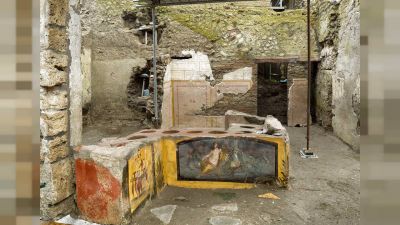In late December, researchers discovered an exceptionally preserved, frescoed thermopolian – the equivalent of a modern-day snack bar – in the archaeological site of Pompeii. The one-time thriving ancient Roman city was washed away by lava during the legendary eruption of Mount Vesuvius sometime around 79 A.D. The thermopolian – a word which derives from the Greek “thermos” for hot and “poleo” meaning to sell, is a known part of Ancient Roman culture. Perfectly preserved by volcanic ash, the snack bar features some intricate fresco art detailing, including an image of a Nereid nymph riding a seahorse and gladiators in combat. Along with the thermopolian’s almost unbelievable standard of preservation, scientists have been able to garner important information around Roman eating habits. Animals depicted in art across the gastronomic wonder are thought to indicate what was available to buy: mallard ducks and a rooster, served alongside wine and hot drinks.
Circa alla fine di dicembre, alcuni ricercatori hanno scoperto un termopolio affrescato eccezionalmente conservato, il termopolio equivale ad un bar dei nostri tempi. È stato trovato in un sito archeologico a Pompei, città romana che fu distrutta dalla lava del Monte Vesuvio, nell'eruzione dell'anno 79 d.c.. Il termopolio, una parola greca dove "terma" signifca calore e "poleo" significa vendere, fu molto conosciuto nella cultura romana antica. Il termopolio trovato intatto è stato perfettamente conservato dalla cenere vulcanica. Il bar presenta affreschi con tanti dettagli, include l'immagine di una ninfa Nereide che montava un cavalluccio marino e dei gladiatori in combattimento. Con il termopolio, ben conservato, gli scienziati hanno potuto raccogliere più informazioni del modo di mangiare per gli antichi romani. Gli animali dipinti nell'affresco danno un'idea dei cibi mangiati durante questa epoca come le anatre domestiche e un gallo, servite con vino e bevande calde.



